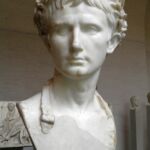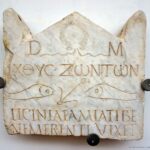More content
The influence of the Hellenistic current caused great changes in the religion of ancient Rome. Traditional religion began to disappear and some new worships of the eastern gods came up, eg. Cybele, Isis or Mithra. Also, astrology and the practice of magic became more popular. The Senate abusing fortunetelling for political purposes contributed to the loss of priests’ authority in society.
The early Roman religion was not able to fulfil the needs of modern humans. Some of them, while dealing with adversities, looked for consolation in the study of happiness and life after death, the others – in philosophical systems. The rulers’ target was to weld the people of the empire with the worship of Caesar.
Evolution of Roman faith
The adoption of the Greek gods’ anthropomorphic traits into Roman culture and, maybe even to a greater extent, the spread of Greek philosophy among the well-educated Romans, caused the rising neglect of the old customs and in the 1st century BCE the significance of the customs was weakening rapidly. Many people, who were dictated by their patrician background to fulfil those duties, did not believe in their effectiveness (besides the political aspect) and the uneducated masses were more into foreign rituals. Nonetheless, the position of pontifex maximus and augur remained highly wanted. Julius Cesar used his choice to influence the members of the colleges.
The comprehensive reform and the renewal of the old system were carried out by Augustus who himself became a member of all the priest groups. Despite the fact that the old customs had hardly anything in common with morality (it was in fact a kind of a deal with the gods – for providing certain services people received protection in return) they emphasized devotion and religious discipline and it is why they were used by Augustus as a way to preserve the domestic peace. During that time Vergil wrote Aeneid and thus popularised the myth of the founding of Rome by Aenaes, a Troian hero.
For all the reforms introduced by Augustus, religion in the empire began to concentrate more and more on the reigning house and finally, the society got into deifying the death caesars. Such a situation began with Julius Caesar, even before the establishment of the empire. Also, Augustus, Vespasian and Titus were deified, but after the reigning of Nerva (96-98 CE) only a few caesars did.
The wide range of foreign worship became popular and spread in the Empire, such as the cult of the Egyptian goddess Isis and the Persian god Mithra, which in some aspects resembled Christianity. In the reign of Constantine I, Christianity became to be officially acknowledged by Rome. Among many different beliefs, Christianity was clearing the way for being the only religion in the country. Theodosius the Great by banning pagan rituals gave the quietus to Roman religion, however, its elements survived in some Christian and folk customs.
The character of Roman religion
In its beginning Roman religion was marked by its practicalness, concreteness and impersonality. Ancient Roman beliefs were closely associated with rustic society. In Romans’ understanding each activity, even the smallest one, had its deity. Aside from the main gods, like Iovis and Mars, there was a huge variety of minor tutelary deities responsible for different activities, either in life or in the household. They had a narrow range of power and took care only of some particular aspects of tillage, cereals, rearing of cattle or generally human life. The example of child upbringing illustrates it the best. Vaticanus opened the child’s mouth from its first cry, Cunina looked after the crib, Runina took care of the feed and after weaning the baby Potina and Edusa taught it to eat and drink. Cuba cared for moving the baby from the crib to the bed, Ossipago watched the baby’s bones to set properly, Statnaus tended to them to learn how to stand and Fabianus how to speak, even their first exit from the house was guarded by Interduca and Domiduca. Each success or even the smallest failure could be the result of the god’s anger or disapproval. All Roman deities were mainly impersonal, sometimes even their sex was not determined. That is why the Romans were praying: “Whether you are a god or a goddess, a man or a woman”.
Roman gods did not descend and show themselves so eagerly on earth as the Greek gods did. They did not help people directly even if it was just a warning. All that was known about deities was that one should offer sacrifices and worship them constantly. There were books full of prophesies and prayers for different occasions.
Romans were considered to be religious by other peoples, their attitude towards gods was really serious but also practical. It was based on a bilateral deal “I give you in order that you give me” (do, ut des). What is interesting, the Romans thought that the bees were the gods’ messengers. Roman religion was marked by its tolerance towards other beliefs and particular hospitality. During the war, they were praying to the enemies’ gods to leave the besieged town and live in Rome. This “hospitality” on the other hand, opened the way for foreign cults and accelerated the changes in Roman religion.







